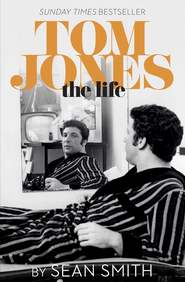По всем вопросам обращайтесь на: info@litportal.ru
(©) 2003-2024.
✖
Spice Girls: The Story of the World’s Greatest Girl Band
Автор
Год написания книги
2019
Настройки чтения
Размер шрифта
Высота строк
Поля
She obviously stood out. It wasn’t just that she fitted his vision for the make-up of the group. She had a personality and charisma that shone. Chris recalled, ‘For me, she was the one who walked in and seemed the full package. She was good but she also just had the look. Her image was on point. She could sing and she had a big personality. On the day, I immediately thought, We have found one.’
Melanie had enjoyed the experience so much that she decided to skip the afternoon audition for the cruise ship, preferring to chat to some of the other girls before making her way back to Victoria station to get the coach home. Chris had told her he would be in touch and Melanie was confident she’d got it. She was right.
3
Mein Herr (#litres_trial_promo)
Victoria Adams-Wood, as she was calling herself then, carried herself differently from the other hopefuls at the Danceworks audition. She was a curvy nineteen-year old, strikingly dressed all in black, with a crop-top showing off her very tanned midriff.
On his mood board back at the office, Chris Herbert had been toying with the idea that one of the group should appeal to the more mature man. He was looking for a young woman who might turn the head of a male consumer with a dash of discernment. You don’t need to be posh to have a touch of class and that was the quality Chris was seeking.
Victoria came from a North London working-class background. Her dad Tony Adams, the son of a factory worker, had been brought up in a two-bedroom house in Edmonton that had no bathroom, an outside toilet and no heating. These were the austere years that followed the end of the Second World War when money was rationed just as much as food had been during the conflict.
In 1957 when Tony was eleven, Prime Minister Harold Macmillan famously said, ‘Most of our people have never had it so good,’ which was small consolation for the youngster hanging around outside the pub waiting for his father to finish his pint. Sometimes he would be pressed into collecting cigarette butts from the overflowing ashtrays for his dad to smoke. Truly, Edmonton was a place to aspire to leave in order to make something of yourself in the world – and that was what he did.
Despite its drawbacks, Edmonton then had a strong sense of community and families had pride in their modest surroundings. The planners of sixties Britain have much to answer for in retrospect, bulldozing away those strong neighbourhood bonds in favour of anonymous tower blocks. Families there pulled together and survived together. Tony absorbed that spirit and passed it on to his eldest daughter.
Tony left school to train as an electrician but dreamt of being a pop star. He was unlucky. He shone as the lead singer in two groups, first in the Calettos and then in the Soniks, which was mainly a covers band. The biggest gig he played was at the famous Lyceum Ballroom on the Strand in London.
He caught the attention of the legendary impresario and manager Joe Meek, who had been responsible for one of the biggest hits of the sixties, ‘Telstar’ by the Tornados, the first US number one by a British group. Joe signed Tony to a contract but, unknown to many in the music business, his life was falling apart because of money problems and blackmail relating to his homosexuality. In February 1967 he murdered his landlady, Violet Shenton, then killed himself with a shotgun.
The difficulty for Tony, who had just recorded his first demo, was that he was under contract at the time and subsequent legal red tape prevented him from recording for five years. This huge disappointment meant that he was always extremely careful when it came to business and, in particular, contracts – a trait inherited by his daughter that would prove to be vital in the progress of the future Spice Girls.
Tony picked up his trade again, working as a rep for an electrical company. He already had ambitions to start his own company, supported by his girlfriend Jackie Cannon, a trainee hairdresser from Tottenham, who soon gave that up to join an insurance company in central London.
Jackie’s father, George, was a stevedore in the docks, loading and unloading ships. He worked all hours to improve his family’s life, an ethic that Tony and Jackie followed over the years, in much the same way as Melanie Brown’s parents. Tony and Jackie married in 1970 but waited four years to start a family, building a better future by moving out of London before their daughter Victoria Caroline was born on 17 April 1974 in the Princess Alexandra Hospital in Harlow, which technically made her an Essex girl.
In 1977, when Victoria was three, Tony bought the Old School House in Goff’s Oak, Hertfordshire. The place needed a lot of work but he had the skills and the contacts in the building trade to do it up himself. But, perhaps more importantly, it had a large garage, which would become the hub of his new electrical-supply company.
Goff’s Oak liked to call itself a village but was quite suburban, if full of people doing rather well for themselves. One ex-teacher at the local school observed witheringly, ‘Wait outside the school gates on any given day and you’d wish you had shares in a fake-tan company and one making leather trousers. They are women with too much time on their hands. They have nothing better to do than shop and get their hair and nails done.’
The media would always make much of Victoria being dropped off at school in her dad’s Rolls-Royce. That was much later. For now, she was driven in her father’s old Hillman, which also doubled as his delivery van. Victoria was a quiet little girl, who struggled with a lack of confidence, particularly in English, and took extra lessons in reading, comprehension and spelling. She was a million miles away from the outspoken woman with the ready wit she would later become.
Tony loved listening to the Beatles and Stevie Wonder, and would dance his little girl around the house to the sound of the great Motown star’s hit ‘Sir Duke’, which Jackie said gave her daughter her love of performing. One teacher, Sue Bailey, recalled, ‘She always loved acting and enjoyed our drama lessons. She liked to sing and dance. She shone one year as Frosty the Snowman. She was a very sweet girl.’
Victoria was inspired by the iconic film Fame. She envied the energy and the exuberance of the students skipping down the corridors of the High School for the Performing Arts in New York. She wanted to be Coco, the multi-talented character played so memorably by Irene Cara. It’s easy to imagine the Spice Girls dancing on the desks and singing in the streets with the rest of the students.
She stuck a poster on her bedroom wall of the dashingly handsome Gene Anthony Ray, who played Leroy in the film and the subsequent TV spin-off. Ironically, Gene became a victim of his own fame, sinking into a life of drink and drugs and dying young, at forty-one.
Victoria was obsessed by the TV show, taping every episode so that she could learn all the songs and the dance routines. She persuaded her mum to take her to see the Kids from Fame on tour and subsequently badgered her into finding a ‘Fame’ school near Goff’s Oak. They couldn’t find an exact match but the Jason Theatre School a few miles up the road in Broxbourne seemed the best option for a nine-year-old.
Rather like the Jean Pearce School in Leeds, the Jason had been running for more than thirty years, founded in North London by greatly respected local dance teacher Joy Spriggs. From the first class, Joy identified Victoria as one of her most eager students, prepared to work her tap shoes off to improve: ‘At the time, all the children wanted to do jazz dancing, with the ankle warmers and the leotards and the colourful catsuits. There was Hot Gossip on television and they wanted to copy that. It was the style of the time.’
Victoria may not have been the most talented dancer ever to grace the Jason Theatre School but she made a dramatic improvement through hard work, determination and old-fashioned practice. Quite simply, the harder Victoria worked, the better she became. Joy observed, ‘She had a certain natural ability and we just channelled it in the right way. Victoria would shine because she was a very pretty little girl, with big dark brown eyes and long dark curly hair, but she was a little bit self-conscious to start with. She didn’t hold back but she wasn’t quite as confident as some of the others. We had to build that confidence with her.’
Her self-belief was boosted when the Jason Theatre School linked up with the local amateur dramatic society for productions of Hello Dolly, Sleeping Beauty and The Wizard of Oz, in which she played a Munchkin. Her ambition was also fuelled by trips to the West End to see the most popular musicals of the eighties – Cats, Les Misérables, Starlight Express and Miss Saigon.
Week after week, dancing provided a welcome escape from real school for Victoria. After the relatively quiet waters of primary school, her parents decided to send her to St Mary’s High School in Cheshunt where she stood out like a beacon, unhappily.
By this time Tony’s business was thriving and the family had plenty of money. The Old School House was now one of the grandest homes in the village, with a swimming pool in the back garden and the Rolls-Royce, with its personalised number plate, in the driveway. It was his pride and joy, although Victoria maintained she hated it.
She had to say that because it might have alienated a million potential Spice Girls fans to hear tales of Daddy dropping her off in the Rolls-Royce. Victoria has always been careful not to describe any days that began with a ride in the Roller and ended with a dip in the pool.
One of her best friends growing up, Emma Comolli, recalled that, perhaps unwisely, Victoria would talk about how rich her family was and how she was going to be famous one day: ‘The other children would turn on her and call her names.’
Another girl said simply, ‘Victoria was considered snooty.’
The full extent of the bullying Victoria suffered at school is a grey area. She was certainly verbally abused but her younger sister Louise recalled, ‘I don’t think she was bullied that badly.’
In the early days at the Old School House the two girls shared a bedroom, but that changed when Tony had finished the remodelling and Victoria had her own pink explosion of a room with giant posters of Bros and Ryan Giggs vying for space with Gene Anthony Ray.
Louise fitted in well at school and found herself having to stick up for her elder sibling. Their different personalities highlight why Victoria had a tough time. Ironically, considering the pack appeal of the Spice Girls, she was never one of the girls. She had a natural shyness that could be exploited by others, but beneath that apparent vulnerability was a girl who was thoroughly determined and as tough as old boots.
Fortunately, there was some enjoyment to be had at school in its lavish dramatic productions. Victoria was one of the best dancers in Les Misérables and Jesus Christ Superstar. Her passion for dancing was a double-edged sword. It gave her a sense of escape but also meant she seldom socialised with classmates. Boys were not on the agenda, although she did have a date aged fifteen with an American pupil called Franco McCurio who took her to the movies. The most memorable thing about it was that it marked the first time she had ever been on a bus.
Victoria met her first proper boyfriend in the kitchen of the Old School House when she was sixteen. Mark Wood had come to fit a burglar alarm. He was three years older, six foot two, and the epitome of tall, dark and handsome. They started chatting and she readily agreed when he asked her out on a date.
She didn’t have to travel by bus, which was a relief, when they went out for a drink to a wine bar. Instead, he picked her up in his dad’s white van, having taken the ladders off the roof for the occasion. Technically, Victoria was too young to be served alcohol but that didn’t stop her getting tipsy, although Mark did not take advantage.
Being in a committed relationship with Mark was not necessarily the most important thing in her life that year. She was determined to leave St Mary’s to further her chances of a career in show business. She set her heart on going to a stage school. She still regretted not going to a ‘Fame’ school like the Sylvia Young Theatre School or the Italia Conti.
Victoria did a tour of the leading ‘finishing’ schools in and around London before deciding to apply to Laine Theatre Arts in Epsom. Joy Spriggs approved: ‘Laine is the crème de la crème really.’ The audition was itself an ordeal and a good grounding for more nerve-racking battles later on. One fellow student from Victoria’s year recalled that Betty Laine had a fiery disposition: ‘You wouldn’t want to cross her. She and the teachers present managed to convey a sort of good-cop-bad-cop aura. She was the bad cop!’
Not for the last time, Victoria had no idea if she had made a good impression so she was thrilled when she was accepted. Joy Spriggs and her other mentors at the Jason Theatre School were equally delighted, especially as Victoria was one of three that year considered promising enough to win grants from the local education authority. Joy observed, ‘I know her parents would have paid for her to go there but she deserved her place. She’d worked hard for it and it is so competitive. For the school to get three in with scholarships was quite something. They were a talented bunch.’
Victoria’s successful application demolishes the opinion that she has no talent or was in some way lucky to achieve any success. Laine accepted only serious, dedicated and talented young people. It had its Premier League reputation to maintain.
Leaving the Jason Theatre School was quite a wrench. It had been her comfort blanket and her inspiration for nine years. She never forgot how much it meant to her and in 2001, as a worldwide superstar, she went back to present the prizes when the school celebrated its fiftieth anniversary. Joy gave her the Jason Anniversary Award – the equivalent of a lifetime achievement award. Victoria told the girls, ‘I wanted to come to the school to give back something that they’ve given me.’
She was not so sorry to leave St Mary’s, although she managed five GCSE passes and won a cookery prize. She left school and home at the same age as Melanie Brown but there was a world of difference between the bright lights of Blackpool and the gentle Surrey town of Epsom. It was too far to commute from Goff’s Oak so Tony drove her to some lodgings.
Victoria was quite young and protected for her age. One friend from Goff’s Oak remembered, ‘She was quite naïve when she went to college, not very streetwise at all.’ She made sure she went home every weekend. Slow to settle in, she rang Mark in tears. He recalled, ‘The teachers told her she was too fat. She had put on a few pounds after going on the pill. She said the other girls were awful and she wanted to come home.’
Even the slimmest of girls would be told to watch their weight at a dancing college. It’s the last thing any young woman would want to hear but Victoria was not being singled out. She was a healthy size twelve. By no stretch of the imagination was she fat – but in dancing terms she was not one of the slender visions that glide around in tutus.
Joy Spriggs explained that dance colleges would tell all the female students that they needed to lose weight if they wanted to get work: ‘They just want the girls to be slim, particularly if they are doing lift work. The boys won’t want to lift them if they’re overweight, will they?’
The girls lived in fear of putting on a few pounds. One fellow student explained, ‘It was generally accepted that if you put on a little too much weight in the holidays then Betty would have no qualms in telling you that you were too fat and needed to sort it out ASAP. We were constantly fretting about this possibility.’
Victoria liked a McDonald’s when she was out – there was a convenient branch on Epsom High Street – and her mum’s meals when she was home. She enjoyed cooking for Mark, particularly pasta. And she loved chocolate, so dieting was not an easy prospect. Like many of her peers, she took up smoking cigarettes to try to suppress hunger pangs. It was bad enough having to deal with the teenage nightmare of acne without having to worry about weight too. She was becoming very body-conscious.
Victoria did not stand out among many fine dancers in her year but she did excel in one of the courses at Laine’s. She was the star pupil in image classes. Betty Laine explained, ‘She was always very conscious of image, which is, of course, paramount to success. If they are going into the pop world, image is very important. She took it extremely seriously. She was always first or second in our image classes.’
Now seventeen, Victoria was beginning to get a better grip on things. Her parents had bought her a Fiat Uno and some driving lessons for her birthday. They also splashed out on a flat in Epsom where she lived with four girls from college. That meant they could visit her regularly and so could Mark.
She was also developing her image and plotting her professional future. She had some photographs taken locally by Geoff Marchant, whom most of the students used for their portfolios. She knew the look she wanted or, more precisely, the one she didn’t. Geoff recalled, ‘She didn’t want to make herself girly and she didn’t want to make herself pretty-pretty. She wanted this moody sort of expression, even though it meant there was a lot of shadow, which didn’t help her skin at all.’
Eventually Geoff persuaded Victoria that it might be a good idea to smile for a few shots in case an agent down the line asked her for something more cheerful. She insisted on wearing black for almost all of the pictures, though. At the time Geoff thought she was quite a cold young lady, but his view changed: ‘I think it may well have been a mixture of shyness and determination.’










